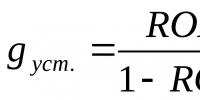What invention can be made from syringes? Well, just think, an injection! The history of the invention of the syringe is full of light and dark stripes
IN modern world syringes are used to inject medications or nutrients under the skin, as well as to suck out liquids and rinse cavities. The history of the syringe dates back to the middle of the 19th century, but humanity used various ways introduction and removal of fluids from the body for a very long time. For example, Hippocrates used a hollow tube to which he attached a pig's bladder, and in the 17th century many scientists used a bird's feather for injections.
The design of the syringe itself was invented back in 1648 by the famous mathematician and physicist Pascal. But the public of that time did not appreciate Pascal’s injector and forgot about this invention. Only by the middle of the 19th century, Dr. Alexander Wood, using Pascal’s injector as a basis, designed a syringe for injecting medicine under the patient’s skin. And around the same time, surgeon Charles Gabriel Pravaz came up with a similar syringe, but of a larger volume. He used it during operations.

The world's first syringes were made of rubber and leather, and dosage notches were made on the piston itself. And the first glass syringes appeared in 1894. They were started to be produced by the Luer company, using the idea of the glass blower Fournier. The company produced syringes with volumes ranging from two to one hundred milliliters.

Almost sixty years later, in 1949, American Arthur Smith patented the first glass disposable syringe. And seven years later, New Zealand pharmacist Colin Murdock invented the world's first disposable plastic syringe. By 1970, Mardock had a patent for a disposable syringe in all countries of the world, and industrial production of plastic syringes had been established since 1961.

Currently, attempts to improve the syringe do not stop: scientists are trying to make injections painless and come up with a design that would not allow the syringe to be used twice.
Today, syringes are used for intramuscular, intravenous, subcutaneous and other types of injections, as well as for washing cavities, suctioning fluids and administering nutrients. Despite the fact that the history of the creation of the syringe dates back to the middle of the 19th century, humanity has long used a wide variety of methods for introducing and removing fluids from the body. So, 2.5 thousand years ago, Hippocrates, known to us, used a hollow tube to which a pig’s bladder was attached. In the 17th century, many scientists and doctors attempted intravenous and subcutaneous injections, as well as transfusions using bird feathers.
In general, the design of a press, that is, a cylinder, a piston and a needle, was invented by the French physicist and mathematician Pascal in 1648. It’s called Pascal’s injector. But, unfortunately, the public of that time did not appreciate this development, and the invention was forgotten. It was only in the middle of the 19th century that Dr. Alexander Wood, using an injector as a basis, designed a syringe for injecting drugs under the skin. At the same time, surgeon Charles Gabriel Pravaz created a similar device with a larger volume for use during operations.


The first syringes in history were made of leather and rubber, and dosage notches were made on a metal piston. Glass reusable syringes manufactured by Luer appeared in 1894. Their design was based on the idea of the glass blower Fournier. The syringes were produced in volumes from 2 to 100 ml, had a conical connection between the needle and the syringe barrel and were made of chemically and thermally resistant glass, which made it possible to successfully sterilize them using various methods. 
The history of the creation of disposable syringes began with the development of the American Arthur Smith, who in 1949 patented the first glass disposable syringe. And just seven years later, New Zealand pharmacist Colin Murdock invented a plastic disposable syringe. In subsequent years, he was actively involved in refining and patenting his invention, and by the 70s of the twentieth century, Mardock had a patent for a disposable plastic syringe in all countries of the world. And their industrial production has been established since 1961.
Currently, developments are being carried out in two directions: firstly, the creation of syringes that, in principle, cannot be used twice, but so far there are no clear results, and secondly, reducing the pain of injections. For example, serrated needles with a smaller contact area with the skin, devices that insert needles at high speed have been created, and a method for freezing needles before injection has also been developed.
An ordinary medical syringe, available to literally every person in our time, is one of the most significant and significant inventions, which has made it possible to approach the issue of treating many diseases from a completely new angle. Moreover, along with the syringe, pharmacology began to actively develop, and scientists began to create drugs that can be effectively used only intravenously or intramuscularly.
It is worth noting that relatively primitive prototypes of modern syringes have almost always existed. Historians and archaeologists have found various evidence of the active use of such structures back in the 10th - 12th centuries throughout Europe. Of course, in those days, syringes were extremely primitive and were made from a bull's bladder and special hollow metal tips. According to research, a thin incision was made in the vein with a sharp knife, and then a mechanism with a drug was quickly inserted into the resulting hole. Obviously, the variety of medicines in those days was very scarce, and therefore such technologies remained the prerogative of rich and influential people.
Inventions of the first medical syringes
But in his modern form the medical syringe appeared, or rather was officially patented in 1853. And what is especially interesting is that it was invented almost simultaneously by two independent specialists who had never communicated with each other and even lived in different countries. One of them, the Frenchman Charles Gabriel Pravaz, was a veterinarian, and the second, the Scotsman Alexander Wood, treated people. It is also interesting that each of these inventors needed a syringe for their own reasons.
Pravaz worked with various animals, and since they all tolerated treatment quite restlessly, he needed the medications to enter directly into the blood, because in this way they began to act much faster, which means it was easier to control the animal, and perform all procedures much faster .
As for Alexander Wood, he invented the syringe in order to relieve some of his patients from severe pain. At that time, general anesthesia consisted of a mixture of nitrous oxide with chloroform and ether. This compound was very harmful to many people, greatly weakening them after surgery, and many even died from its effects even before the operation began. In this regard, medical researchers began to develop an alternative, which became morphine. It was much safer, but the drug was very poorly absorbed through the digestive tract, and Wood decided that direct injection into the blood would correct the situation.
The structure of the first syringes among the inventors was somewhat different, but they soon came to a common solution. The first syringes had an opaque rubber barrel and a metal plunger and needle. Since it was impossible to determine from the outside how much liquid was in the syringe, measuring notches were made on the piston itself. This invention very quickly became extremely popular and brought medicine to a fundamental level. new level, because now in many cases it was possible to do without surgical intervention, and many medications began to act much more effectively.
In this format, this invention existed for quite a long time, and the following major changes with the technology of interstitial administration medicines occurred in 1894, when the famous French glassblower Fournier made syringes with glass cylinders.
The first disposable syringe and its evolution
But in 1950, American inventor Arthur Smith decided to move in a different direction and patented disposable syringes consisting of a glass cylinder, a plastic piston and a thin long stainless steel needle. This invention also quickly gained great popularity, since doctors no longer needed to boil and disinfect syringes many times, and thanks to the enterprising patent holder, the new product quickly became very cheap and widely available. And just 6 years later, a doctor from New Zealand simplified the production technology and patented his own disposable, completely plastic syringes.
Other types of medical syringes
Over the next two decades, the production technologies for disposable and reusable medical syringes changed somewhat until they came to a single format, which they still use today. Later, on their basis, various specialized prototypes began to be created, intended for some specific purposes. These include, for example, an insulin syringe with a very short needle that does not cause pain. It was made so that people suffering diabetes mellitus, were not afraid to give injections to themselves. Another interesting variation was the large Zhanet syringe, designed for pumping out liquids and washing the internal cavities of the body.
It is also worth noting that in order to prevent the repeated use of disposable syringes, as the main way of contracting AIDS among drug addicts, many developers are creating syringes that are physically impossible to reuse. However, so far there is no sufficiently economical and effective solution to this issue.
Nowadays, a syringe is an indispensable medical tool, which is also used for various household purposes, but few people know what the history of this simple device is. The prototype of the syringe was created by the ancient Greek physician and philosopher Hippocrates, who lived in the 5th - 4th centuries BC. Back then, the syringe was a hollow tube to which a pig's bladder was attached.
But centuries passed and syringes began to improve and change their shape.
Brass syringes that were made in France in the 17th century have been preserved. In 1648, the French scientist Blaise Pascal made a syringe that consisted of a cylinder, a piston and a needle, but the device was not widespread among doctors and was soon forgotten.

Syringes similar to the ones we use today appeared in 1853. They were invented by two people separately from each other. Scotsman Alexander Wood created a syringe to make subcutaneous injections, and Frenchman Charles Gabriel Provaz needed a syringe for surgical purposes. The syringes of the 19th century were made of rubber, and it was not until 1894 that the French master glassblower Fournier made the first glass syringe. In 1906, they created the Record syringe with a glass cylinder sealed in metal rings and a piston with rubber seals.

The idea of creating a disposable syringe belongs to pharmacist and veterinarian Colin Murdoch. In 1956, at the age of 27, he was vaccinating animals and suggested that the drug, pre-sealed in syringes, would help speed up the vaccination process. This is how the first disposable syringe appeared. Murdoch continued to work on improving his device and disposable syringes began to be used to treat people. In 1961, disposable syringes began to be produced on an industrial scale.

Then, for medical manipulations, bovine or pig bladders were used, into which a tube made of wood or reed was inserted. It took centuries for the syringe to finally acquire the appearance we are accustomed to.
In many European languages, the name of the syringe today is consonant with the ancient Greek word “syrinx”, which means “reed”. The Russian name of the instrument comes from the German “spritzen” - “to splash”.
A device for pumping or suctioning liquids, described by the ancient Greeks, turned out to be a very valuable invention. By the end of the 15th century, it became the same symbol of the medical profession as the stethoscope is today, and long years, until the middle of the 19th century, was actively used in the treatment of many diseases. However, we now call this simplified version of the syringe an enema.
Create and forget
The honor of inventing the pump, and with it the prototype of the syringe, apparently belongs to the great Greek scientist and mechanic Heron of Alexandria, who lived in Egypt in the 1st century AD. In his work Pneumatica, he talked about a variety of devices powered by compressed air, water or steam.
The first more or less reliable description of the syringe itself as a medical instrument dates back to the twentieth century, when Egyptian surgeon of Iraqi origin Ammar ibn Ali al Mosuli used a hollow glass tube and the suction effect of the movement of a piston inside it to remove cataracts from the eye.
Unfortunately, such a useful invention did not cause special interest among doctors of the past, and it was quite firmly forgotten until the middle of the 17th century.
Photo: Shutterstock.com
The first damn thing is lumpy
After publication in 1628 English physician William Harvey work about the circulatory system he discovered, many researchers became interested in the issues of blood transfusion, as well as how effective the delivery of painkillers directly to the place affected by pain can be.
Among others, he began to actively experiment with injections and blood transfusions (including from animals to humans) German botanist, alchemist and physician Johann Sigismund Elsholtz. Knowing nothing about blood groups and their incompatibility, he even recommended blood transfusion as a means to solve the most unexpected problems that arise among relatives or spouses. Thus, in his opinion, as a result of the transfusion procedure, the blood of a melancholic husband could be refreshed with the blood of his energetic wife, and thus married life would become more harmonious. The color of black urine, which was subsequently observed in some patients, was then interpreted as a cleansing release of harmful substances. Of course, these early experiments were generally ineffective and in many cases ended fatally. But the most interesting thing for us is that in Elsholz’s book Clysmatica Nova, published in Berlin in 1667, we find an image of a syringe that is easily recognizable today. Only then he was without a needle.
Failures with blood transfusions and injections forced us to forget about the use of a syringe for these purposes for many 200 years. All this time, our hero had to work in the field of medicine as a primitive irrigator or a device for sucking various fluids from the body.
Tricky and painful
The goal of creating a simple and convenient injection syringe was definitely achieved only in the first half of the 19th century. At first things didn't go very smoothly.
In 1841 American Zophar Jane patented a syringe with a sharp tip. The introduction of drugs into the tissue was complicated by the need to make a preliminary incision in the skin using a lancet.
Three years later Irish doctor Francis Rind from Dublin described the subcutaneous administration of medicine using a complex stylet of an original shape. With this device, he tried to alleviate the suffering of a patient with trigeminal neuralgia by forcing the solution to penetrate the tissue under the influence of gravity. Rind hoped that if he could introduce a sedative into the patient's body, the pain would be relieved much faster than if he took the medicine orally. Ultimately, he was unable to find a painkiller, but the doctor’s efforts were not in vain, because in the process of searching he invented a hollow needle. To be fair, it must be said that this design was not at all like a modern hypodermic syringe, but the action was similar.

Photo: Shutterstock.com
Get stuck and forget
 Around the same time, living in Scotland Secretary of the Royal College of Physicians of Edinburgh Alexander Wood experimented with a hollow needle to inject drugs into the bloodstream. Success came in 1853, when the hypodermic syringe was finally created. They say the invention allowed the doctor to administer morphine to his wife, who was diagnosed with cancer. Thus, Wood's wife became the first patient who received the drug through injection and, as a result, became addicted to the needle. Wood's invention contributed to the indiscriminate use of morphine as a remedy for all types of pain. With the blessing of doctors, morphine began to be injected into the veins of everyone suffering from gout, rheumatism or even toothache. As the most powerful painkiller, it was widely used to relieve the suffering of the wounded in Civil War in the United States, but many combatants returned home complete morphine addicts. It is estimated that there were more than one and a half million such unfortunate people. The Franco-Prussian War of 1870 created an identical situation in Europe. “Soldier’s disease” rapidly conquered the world, as a result of which medicine was faced with the problem of detoxifying millions of drug addicts.
Around the same time, living in Scotland Secretary of the Royal College of Physicians of Edinburgh Alexander Wood experimented with a hollow needle to inject drugs into the bloodstream. Success came in 1853, when the hypodermic syringe was finally created. They say the invention allowed the doctor to administer morphine to his wife, who was diagnosed with cancer. Thus, Wood's wife became the first patient who received the drug through injection and, as a result, became addicted to the needle. Wood's invention contributed to the indiscriminate use of morphine as a remedy for all types of pain. With the blessing of doctors, morphine began to be injected into the veins of everyone suffering from gout, rheumatism or even toothache. As the most powerful painkiller, it was widely used to relieve the suffering of the wounded in Civil War in the United States, but many combatants returned home complete morphine addicts. It is estimated that there were more than one and a half million such unfortunate people. The Franco-Prussian War of 1870 created an identical situation in Europe. “Soldier’s disease” rapidly conquered the world, as a result of which medicine was faced with the problem of detoxifying millions of drug addicts.
How to screw in medicine
 In parallel with Wood, he developed his own syringe design French surgeon Charles-Gabriel Pravas. Luck smiled at him in the same 1853. In the syringe he created, the dosing of drugs was carried out by slowly turning the piston axis. The syringe barrel was originally made of metal, but was gradually modernized, and by 1866 it was made of glass, which allowed doctors to see how much medicine remained inside.
In parallel with Wood, he developed his own syringe design French surgeon Charles-Gabriel Pravas. Luck smiled at him in the same 1853. In the syringe he created, the dosing of drugs was carried out by slowly turning the piston axis. The syringe barrel was originally made of metal, but was gradually modernized, and by 1866 it was made of glass, which allowed doctors to see how much medicine remained inside.
The use of Pravas syringes in various operations soon brought them enormous popularity (for the first time Pravas used his syringe for intravenous administration of anticoagulants in the treatment of an aneurysm). The universal Pravas syringe, close to the modern one, was used in medical practice almost until the middle of the 20th century.
Can't login twice
The publication of Louis Pasteur's works on pathogenic microorganisms led to an understanding of the need for more thorough sterilization of medical instruments, including syringes. Thus, the piston seal made of leather is replaced by pistons made of asbestos, rubber, and nickel-plated metal, which are less sensitive to heat treatment.
Russia also made its contribution to the history of the issue. In 1906, we presented the world with a somewhat cumbersome, but simple, reliable and easy-to-use dismountable syringe “Record”. However, the cheapest option at that time was the Luer syringe, patented in 1895 and made entirely of glass, which consisted of a glass cylinder and a glass plunger without additional “packaging” of material to create a seal between the piston and the cylinder. The only drawback of this syringe was its fragility.
Disposable glass and plastic syringes appeared on the market almost simultaneously in the mid-fifties of the twentieth century. Today, engineers all over the world are struggling with the task of creating a reliable and cheap syringe that could not be reused.




